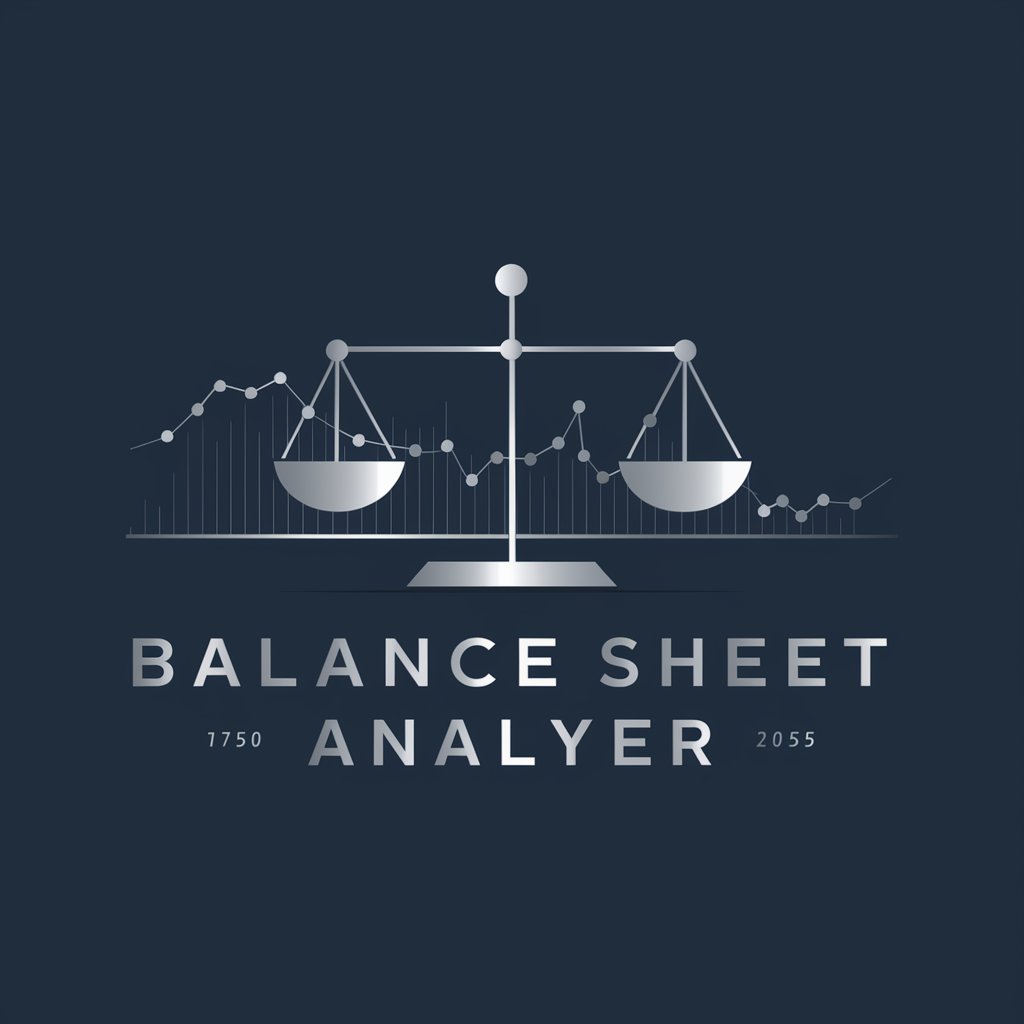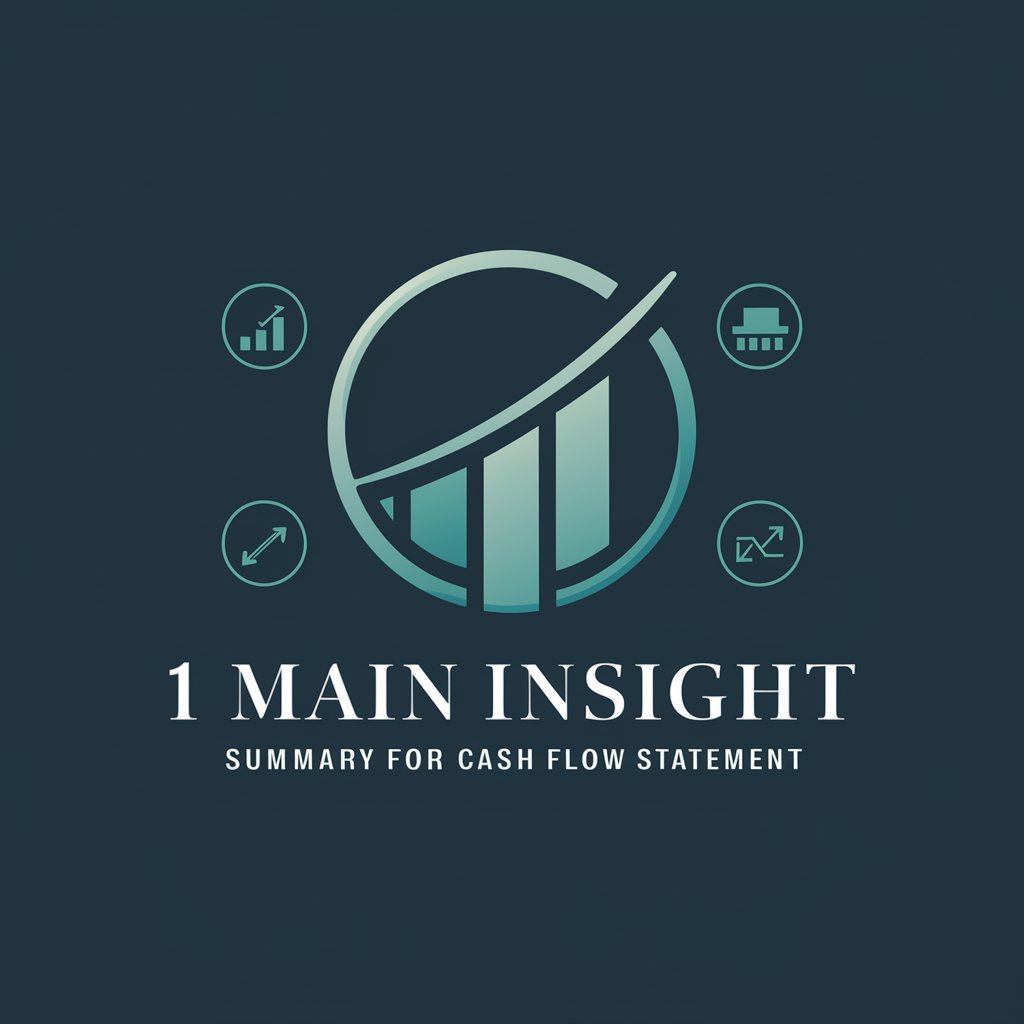
1 Main Insight Summary from Balance Sheet - Financial Ratio Analysis

Welcome! Let's dive into balance sheet insights together.
Simplifying Balance Sheet Insights with AI
Analyze the company's liquidity using the current and quick ratios.
Evaluate the firm's financial leverage with the debt-to-equity ratio.
Calculate the working capital to assess operational efficiency.
Compare the financial metrics to industry standards for a comprehensive analysis.
Get Embed Code
Understanding 1 Main Insight Summary from Balance Sheet
1 Main Insight Summary from Balance Sheet is designed to distill complex financial data into key insights that are critical for assessing a company's financial health. Its primary function is to analyze balance sheet information to calculate and interpret essential financial ratios such as the current ratio, quick ratio, working capital, and debt-to-equity ratio. These metrics provide a snapshot of a company's liquidity, operational efficiency, and financial leverage. For example, by calculating the current ratio, which compares current assets to current liabilities, users can gauge a company's ability to meet short-term obligations. This service is particularly valuable for stakeholders looking to make informed decisions about investments, creditworthiness, and the overall financial standing of a company. Powered by ChatGPT-4o。

Core Functions of 1 Main Insight Summary from Balance Sheet
Calculation of Financial Ratios
Example
For a company with $200,000 in current assets and $100,000 in current liabilities, the current ratio would be 2.0. This indicates a strong liquidity position, suggesting the company can comfortably meet its short-term obligations.
Scenario
An investor analyzing a potential stock purchase uses this function to assess the company's liquidity and risk of insolvency.
Comparative Analysis with Industry Standards
Example
If the industry standard for the debt-to-equity ratio is 0.5 and a company's calculated ratio is 0.8, this might indicate a higher reliance on debt financing compared to its peers.
Scenario
A financial analyst employs this function to evaluate a company's financial leverage in comparison to industry norms, aiding in the assessment of its investment appeal.
Interpretation and Contextualization of Financial Data
Example
Interpreting a working capital of $150,000 as sufficient or insufficient depends on the context, including the size of the company and its industry. A small retail business might find this ample, whereas a large manufacturing firm might not.
Scenario
A business owner reviews their company's financial position before making decisions on expansion or new projects, relying on tailored insights to understand operational efficiencies.
Who Benefits from 1 Main Insight Summary from Balance Sheet
Investors
Investors, both individual and institutional, utilize these insights to make informed decisions about buying, holding, or selling equity or debt instruments. The service aids in understanding a company's financial health and potential future performance.
Financial Analysts
Financial analysts use the service to conduct comprehensive analyses for clients or employers. It helps them provide more accurate recommendations based on a deep understanding of a company's balance sheet and financial ratios.
Business Owners and Managers
Owners and managers of businesses of all sizes benefit from understanding their company's financial standing in relation to industry standards. This insight is crucial for strategic planning, risk management, and operational adjustments.

How to Utilize 1 Main Insight Summary from Balance Sheet
Start with a Free Trial
Begin by accessing yeschat.ai for an introductory experience without the need for signing up or subscribing to ChatGPT Plus.
Gather Financial Statements
Ensure you have the latest balance sheet data of the company you're analyzing. This includes assets, liabilities, and equity figures.
Input Data
Enter the balance sheet data into the provided fields or upload the document if the platform supports file uploads.
Analyze Ratios
Use the tool to calculate key financial ratios such as current ratio, quick ratio, working capital, and debt-to-equity ratio.
Interpret Results
Review the generated insights focusing on liquidity, operational efficiency, and financial leverage, comparing them with industry standards.
Try other advanced and practical GPTs
!Astrology Tutor
Empowering your astrological journey with AI.

Debate Master
Elevate debates with AI-powered insights and visuals

SIMAD iLab AI Mentor
Empowering African Entrepreneurs with AI

Flutter Pro
Elevate your Flutter projects with AI-powered assistance

Y Combinator Mentor
AI-powered guidance for YC applications

Stencil Maker
AI-powered Stencil Customization

Respiratory SCE Tutor
Master Respiratory Medicine with AI

CourageCoachGPT: Speak Up and Advocate for You!
Empowering Voices with AI Coaching

Insight Educator
Empowering Education with AI Insights

Catalan Coach
Master Catalan with AI-powered coaching

Yank Note Helper
Empowering your notes with AI

Code Linguist
Elevate Your C# Code with AI

FAQs on 1 Main Insight Summary from Balance Sheet
What is the significance of the current ratio?
The current ratio measures a company's ability to cover its short-term liabilities with its short-term assets. A higher current ratio indicates better liquidity, suggesting that the company can easily meet its short-term obligations.
How does the quick ratio differ from the current ratio?
The quick ratio, also known as the acid-test ratio, excludes inventory from current assets in its calculation. It provides a stricter assessment of a company's immediate liquidity by focusing only on assets that can be quickly converted to cash.
What does working capital tell us?
Working capital is the difference between a company's current assets and current liabilities. It indicates the operational efficiency and short-term financial health of the company, with a positive working capital suggesting that the company can fund its current operations and invest in future activities.
Why is the debt-to-equity ratio important?
The debt-to-equity ratio measures a company's financial leverage by comparing its total liabilities to shareholders' equity. A lower ratio indicates that a company relies less on borrowing, suggesting a more stable financial structure.
Can this tool predict financial stability?
While this tool provides critical insights into a company's financial health, predicting stability involves considering these metrics alongside other factors such as market conditions, industry trends, and company strategy.





